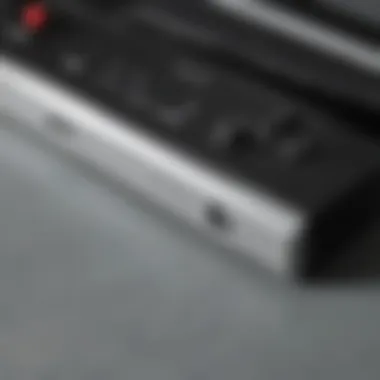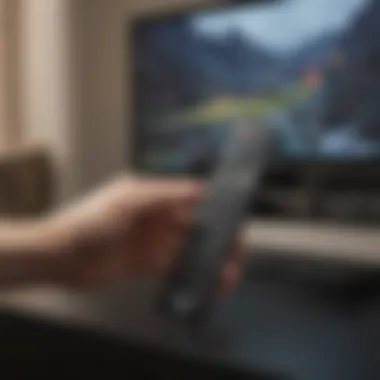Understanding the Wii Sensor Bar: Functionality and Setup


Intro
The Wii Sensor Bar serves as a critical component in the functionality of the Nintendo Wii console. By facilitating motion detection, it creates an interactive experience that transforms traditional gameplay. In this article, we will examine how the Sensor Bar operates, the setup process required for optimal performance, and its overall impact on gaming. This exploration aims to provide insights not only for casual gamers but also for dedicated enthusiasts who seek to deepen their understanding of this unique device.
Overview of Key Points
We will cover the following aspects, illustrating the importance of the Wii Sensor Bar in the gaming landscape:
- The essential functionalities the Sensor Bar provides.
- Clear setup instructions to ensure compatibility and effective usage.
- Troubleshooting tips to help solve common issues that users may face.
- The influence of the Sensor Bar on gaming experiences, including motion control accuracy.
- Alternative technologies available that offer similar functionalities.
- Suggestions for optimizing performance to enhance user experience.
With this information, readers will gain a comprehensive understanding of the Wii Sensor Bar, enriching their gaming journeys.
Intro to the Wii Sensor Bar
The Wii Sensor Bar serves as a pivotal component in the Wii gaming experience. Its correct functioning enhances gameplay by providing the necessary feedback mechanisms that allow for intuitive motion control. Understanding the Sensor Bar is essential for both novice and seasoned players alike.
Overview of the Wii Console
The Nintendo Wii was released in 2006 and quickly gained popularity for its innovative approach to gaming. Unlike traditional consoles that relied on complex controllers and intricate buttons, the Wii introduced a more physical method of interacting with games. This was made possible by the Wii Remote, which utilizes motion sensing technology.
The Wii console appeals to a broad audience, from casual gamers to families seeking interactive entertainment. Its library offers diverse titles that cater to various interests, making it a unique entry in the gaming world. The Wii's success can be attributed to its accessibility and the engaging nature of its gameplay.
What is the Wii Sensor Bar?
The Wii Sensor Bar is a vital accessory that works in conjunction with the Wii Remote. It consists of a series of infrared LEDs that detect the positioning and orientation of the Wii Remote. This detection is crucial for translating physical movements into in-game actions. Essentially, the Sensor Bar captures the remote’s movements, allowing players to point, swing, and navigate their way through the digital landscape.
When set up correctly, the Sensor Bar enables seamless interaction, transforming gameplay into a dynamic experience. It is an essential link between the player and the console, ensuring that games can be enjoyed in a way that feels natural and engaging. Understanding its function and setup can greatly improve user experiences and minimize frustrations.
The Functionality of the Wii Sensor Bar
The Wii Sensor Bar is central to the gaming experience on the Nintendo Wii console. Understanding its functionality is crucial for users who wish to maximize their engagement with the device. The sensor bar not only enables motion detection but also enhances player interaction with games. A clear grasp of its operational principles will unveil its significance, allowing for informed optimal use.
How it Works
The Wii Sensor Bar consists of two main components: infrared emitters and a receiver located in the Wii Remote. When the console is powered on, the sensor bar emits infrared light that is detected by the camera in the Wii Remote. This process is essential for tracking the movement of the controller in relation to the screen.
The ir light emitted creates a field for the Wii Remote to interpret its position. An array of light detects the angle and distance from the sensor to create accurate movement data. Users can point, swing, and navigate with ease.
In practical terms, when a player moves the Wii Remote, the sensor bar interprets this movement and translates it into action on the screen. The response time is generally swift, which contributes to immersive gameplay.
Response to Wii Remote Movements
The response of the Wii Sensor Bar to remote movements is critical for interactive play. As users make gestures, the remote sends signals back to the console via the infrared data it receives from the sensor bar. This two-way communication allows immediate feedback, translating real-world actions into in-game commands.
The precision of this response varies based on several factors:
- Placement of the Sensor Bar: If the bar is misaligned or too far from the remote, it may not detect movements accurately.
- Obstructions: Physical objects between the bar and remote can disrupt the signal, leading to lag.
- Lighting Conditions: External light sources can interfere with the sensor's performance, necessitating control over the play environment.
"The effectiveness of the Wii Sensor Bar ultimately hinges on both its positioning and the environment, determining the extent of user experience."
For successful gameplay, players must understand the relationship between their motion and the sensor’s feedback. Mastering movement techniques can lead to enhanced accuracy and performance.


Physical Characteristics and Design
The design and physical characteristics of the Wii Sensor Bar are crucial for its functionality and overall user experience. Understanding these elements helps gamers optimize their setup and enhance gameplay immersion. The Sensor Bar’s construction and layout significantly influence how effectively it can track movements and respond to player actions.
Dimensions and Materials
The Wii Sensor Bar is a slim, elongated device with specific dimensions designed for ease of placement and use. Typically, it measures about 30 centimeters in length. Its lightweight plastic casing makes it easy to mount on televisions or other surfaces without adding unnecessary bulk.
The choice of materials is also essential. The Sensor Bar utilizes infrared LEDs encased in durable plastic. This construction ensures that the device can withstand daily usage while maintaining functionality over time. Here are some points regarding its dimensions and materials:
- Lightweight Design: This allows for easy handling and reduces installation hassle.
- Durable Casing: Protects the internal components, ensuring longevity.
- Compact Size: Fits well with various screen sizes and setups.
These dimensions and materials not only support the device’s performance but also maintain sleekness in modern gaming setups. The compact design allows gamers to integrate the Sensor Bar seamlessly into their entertainment systems.
Placement and Positioning
Correct placement and positioning of the Wii Sensor Bar are vital for optimal performance. For successful motion tracking, the Sensor Bar must be able to detect the infrared signals from the Wii Remote effectively. Here are some considerations for placement:
- Elevated Position: Mounting the Sensor Bar above or below the television helps ensure a clear line of sight for the infrared signals.
- Distance from the Console: It should be positioned close enough to the Wii console for easy connectivity but far enough not to obstruct gameplay.
- Alignment with Player: The Sensor Bar should be directed toward the primary playing area, maximizing responsiveness to movements.
In summary, positioning the Sensor Bar at an appropriate height and angle enhances responsiveness and user experience. Ignoring these factors can lead to connectivity issues or gameplay limitations. Attention to the physical characteristics and design of the Sensor Bar helps gamers fully leverage the interactive capabilities of the Nintendo Wii system.
Setting Up the Wii Sensor Bar
Setting up the Wii Sensor Bar is crucial for a smooth gaming experience. It enables the Wii Remote to accurately detect movements and perform actions within various games. Proper installation not only enhances the accuracy of motion detection but also ensures that users can fully enjoy the interactivity that the Wii system offers.
Understanding the components and installation process is essential. It helps players avoid common pitfalls that may affect gameplay. This section will outline the required components for setup and provide clear installation steps.
Required Components
To set up the Wii Sensor Bar effectively, a few basic components are necessary. These include:
- Wii Sensor Bar: This is the primary device that allows the Wii Remote to track movement.
- Wii Console: The central unit where games are played.
- Power Supply: The Sensor Bar requires a power source which can come from the Wii console or an external source in some setups.
- Mounting Equipment: Some players may need adhesive strips or a stand to position the Sensor Bar securely. This ensures optimal function.
Having these components ready allows for a smoother installation experience.
Installation Steps
The installation of the Wii Sensor Bar involves straightforward steps. Following these can help avoid unnecessary complications:
- Placement: Position the sensor bar either on top or below your television. Ideally, it should be centered with the screen at eye level.
- Connect the Sensor Bar: Plug the Sensor Bar's cable into the designated port on the Wii console. For wireless setups, ensure that any necessary transmitter is connected.
- Adjust the Angle: Tilt the Sensor Bar if necessary, so it points directly at the player. This helps optimize responsiveness.
- Power On the Wii: Switch on the console to verify that the Sensor Bar is functioning correctly. The lights on the bar should show signs of activity.
- Calibrate the Wii Remote: Once the sensor is active, it is beneficial to calibrate the Wii Remote by following on-screen instructions. This ensures that the system accurately tracks movements.
Proper setup is key to unlocking the full potential of the Wii’s interactive gameplay. A well-positioned Sensor Bar can significantly improve player immersion and satisfaction.
Following these steps, gamers are more likely to achieve a fast and reliable connection between the Wii Remote and the Sensor Bar. A little attention to detail can go a long way in enhancing the overall experience.
Compatibility and Connectivity
Understanding the compatibility and connectivity of the Wii Sensor Bar is crucial for maximizing its potential within the gaming environment. The Sensor Bar is designed to work seamlessly with various devices, primarily the Wii console, but its functionality can extend to other technologies as well. This connectivity fosters an integrated gaming experience. Ensuring that the Sensor Bar is compatible with your devices enhances interactive gameplay significantly.
Supported Devices
The Wii Sensor Bar predominantly supports the Nintendo Wii console. Its design and functionality are tailored to facilitate optimal interaction between the console and the Wii Remote. However, while the Sensor Bar is primarily catering to the Wii, it can connect to certain PCs running emulation software. This allows users to experience Wii titles on their computers through an emulator.


- Nintendo Wii Console: The main device, receiving input from the Sensor Bar for motion detection.
- PCs with Emulators: Software such as Dolphin allows emulating Wii games, using the Sensor Bar for interaction.
- Other Compatible Devices: Some third-party gaming devices may support the Sensor Bar, although direct compatibility varies.
It is essential to check specific requirements and compatibility lists to ensure seamless integration.
Wireless Functionality Considerations
Wireless functionality is another critical aspect of the Wii Sensor Bar. While the bar itself connects to the console via a cable, its impact on wireless devices, like the Wii Remote, cannot be overstated. The Sensor Bar transmits signals that the Wii Remote interprets, allowing for wireless communication between the two devices.
- Distance and Range: The Sensor Bar can operate effectively within a certain range. Users must maintain a clear line of sight to optimize signal strength.
- Obstruction Issues: Any physical barriers between the Sensor Bar and the Wii Remote can disrupt connectivity, leading to performance issues.
- Interference from Other Devices: Nearby wireless devices may cause interference, so consider positioning the Sensor Bar thoughtfully.
When properly set up, the compatibility and connectivity of the Wii Sensor Bar significantly improve the gaming experience, providing fluid motion detection and interaction.
Troubleshooting Common Issues
In this section, we address the common problems that users may face with the Wii Sensor Bar. It is vital to understand these issues because they can severely affect your gaming experience. Knowing how to troubleshoot effectively can restore functionality quickly and enhance your gameplay. This knowledge benefits all users, whether casual gamers or dedicated Nintendo fans, in maintaining optimal performance of their gaming setup.
No Detection by the Wii Remote
One of the primary concerns users encounter is the Wii Remote not detecting the sensor bar. This issue can lead to frustration, affecting your interaction with games. Several factors may contribute to this problem.
- Distance and positioning: Ensure that the sensor bar is properly positioned above or below your TV and that it is within a reasonable distance from the Wii Remote.
- Obstruction: Check for any obstructions that may be blocking the sensor’s signal path. Objects such as books, vases, or even curtains may interfere with detection.
- Connection issues: Make sure the sensor bar is correctly plugged into the Wii console. A loose or damaged connection can prevent detection.
- Battery levels: Verify that your Wii Remote has sufficient battery charge. Low battery levels can impact its ability to communicate with the sensor bar.
If none of these solutions resolves the issue, consider resetting the Wii console. Sometimes, a simple restart can restore connectivity between the devices.
"Ensuring that the sensor bar has a clear line of sight is crucial for proper functionality."
Inconsistent Response Times
Another common problem is inconsistent response times from the Wii Remote when using the sensor bar. This can occur during gameplay, affecting performance and immersion. Similar to the detection issue, several factors can result in this problem.
- Lighting conditions: The sensor bar relies on infrared light. Bright lighting or direct sunlight can affect its performance. Ensure that the area has moderated light levels.
- Sensor bar placement: Improper positioning of the sensor bar can lead to erratic response times. As discussed in previous sections, positioning directly above or below the screen is ideal.
- Wii Remote malfunction: It is also possible that the Wii Remote is experiencing issues. Test the remote with a different sensor bar or verify its operational status with other games.
- Interference from electronic devices: Other electronic devices in proximity to the sensor bar may cause interference, leading to fluctuations in response time. Consider turning off nearby devices to identify if they impact performance.
To summarize, understanding and troubleshooting these common issues is crucial for maintaining the gameplay experience. By following these guidelines, you can minimize interruptions and enjoy a seamless interaction with your Wii console.
Impact on Gaming Experience
The Wii Sensor Bar significantly alters how users interact with games, influencing both the mechanics of gameplay and the overall level of user engagement. This section outlines the various ways the Sensor Bar impacts gaming experiences, focusing on enhancing gameplay mechanics and fostering user interaction.
Enhancing Gameplay Mechanics
The functionality of the Wii Sensor Bar introduces innovative gameplay mechanics that were not commonplace in traditional gaming systems. By utilizing infrared technology, it allows the Wii Remote to detect movements and gestures, translating physical actions into on-screen responses. This movement-based interaction makes several genres of games, such as sports and fitness, much more immersive. For example, players can swing a tennis racket or throw a bowling ball using their actual motions, which imbues the experience with a sense of realism.
Moreover, the Sensor Bar supports a variety of gaming styles and player preferences. The reliance on physical movement encourages players to be more active, which is particularly appealing for those looking for gaming experiences that incorporate physical activity. This leads to an engaging approach to gaming that has been embraced across age groups. By shifting the focus from button-mashing to motion-based interactions, the Wii presents a fresh take on gameplay design.
User Interaction and Engagement
In addition to enhancing gameplay mechanics, the Wii Sensor Bar fosters a deeper level of user interaction and engagement. The intuitive design means that novice players can quickly grasp how to play, which is crucial for family-oriented gaming sessions. As the barriers to entry are lowered, it encourages group play, making it a popular choice for gatherings and social events.
"The Wii Sensor Bar's ability to engage multiple players at once sets it apart from many other gaming consoles."
This multiplayer capability allows friends and family to join in on the fun, enhancing the overall enjoyment of gaming. Group experiences can lead to memorable moments, with laughter and competition emerging naturally during gameplay. Players are not just sitting passively; they are moving, interacting, and connecting with one another.
The sense of competition also plays a key role. With games like "Wii Sports" and others that utilize the Sensor Bar, players often challenge each other, increasing engagement levels. As a result, the gaming experience becomes more than just an isolated activity; it morphs into a shared event, where players actively engage with both the game and each other, fostering community bonds.


In summary, the impact of the Wii Sensor Bar on gaming experience is profound. Through the enhancement of gameplay mechanics and the promotion of user interaction, it transforms traditional gaming into a dynamic and collective activity, enriching the overall experience for players.
Alternative Technologies
The exploration of alternative technologies is crucial for assessing the evolution and possibilities in motion detection systems. As gaming advances, the need for refined interaction methods grows. This section evaluates various systems that may provide similar or superior functionalities as the Wii Sensor Bar.
Comparative Analysis of Motion Detection Systems
Understanding different motion detection systems allows us to appreciate what alternatives exist to the Wii Sensor Bar, and how they enhance user experience.
- Infrared Sensors: These systems, functioning similarly to the Wii Sensor Bar, track movement by detecting heat emitted by the body. They are often more precise in close-range applications, offering a seamless interactive experience. Some gaming setups utilize these sensors with cameras for improved tracking, making them more suitable for player movements in larger spaces.
- Accelerometers: Integrated into devices like smartphones and controllers, these sensors measure acceleration forces to detect motion. They provide instant feedback and can translate gestures into commands. However, their dependency on device speed means they are less effective in a stationary environment.
- Camera-Based Systems: These systems, such as Microsoft Kinect, use depth-sensing cameras to analyze body movements. They can capture a wider range of movements and require no additional remotes. However, camera-based approaches usually need more space and can be sensitive to lighting conditions.
- Wearable Devices: Fitness trackers or VR gloves incorporate motion sensors that offer unique gaming opportunities. They track detailed movements for an immersive experience. Devices like Valve's Index Controllers represent this evolution, taking player interaction to new heights.
Emerging Tech in Gaming
The gaming industry always looks towards future advancements. Several emerging technologies are set to change the landscape of how players interact with their games.
- Virtual Reality (VR): Engaging players in fully immersive environments, VR employs sophisticated motion tracking systems. Players can physically move within virtual environments, shifting the traditional methods of interaction.
- Augmented Reality (AR): This technology overlays digital content onto the real world. Devices like Microsoft HoloLens use sophisticated motion detection capabilities to bring interactive elements into everyday surroundings. The integration of AR in gaming holds promise for creating more interactive and engaging experiences.
- Haptic Feedback Technology: These systems provide tactile response to user interactions. Whether through controllers or wearables, haptic technology can simulate the sensation of touch, elevating immersion.
The growth of alternative technologies suggests a transformative trajectory for gaming interaction. Understanding these innovations helps inform potential advancements in gaming systems.
Tips for Optimizing Sensor Bar Performance
Optimizing the performance of the Wii Sensor Bar is crucial for an enhanced gaming experience. When the Sensor Bar operates at its peak, it significantly improves the precision of motion detection and thereby ensures that gameplay is as immersive as possible. This section will cover ideal configuration setups and regular maintenance practices essential for maximizing the efficiency of the Sensor Bar.
Ideal Setup Configurations
To achieve optimal performance, correct setup is vital. Here are some key configurations you should consider:
- Placement:
Position the Sensor Bar at the center of the television screen. It should be mounted securely on top or below the screen at the same height. This placement allows for the best line of sight to the Wii Remote. - Distance from Wii Remote:
Maintain a distance within six to ten feet for optimum tracking. Between both units, obstacles should be minimized. - Beam Orientation:
Align the Sensor Bar so its infrared beams are unobstructed. Ensure there are no reflective surfaces nearby that could interfere with the sensing. - Lighting Conditions:
Avoid direct sunlight and bright lights in the vicinity, as these can confuse the infrared signals. Dim lighting is preferred for most usage scenarios. - Calibration:
Use the calibration feature in the Wii console settings to adjust sensitivity according to your play area. This ensures precision while using the Wii Remote.
By adhering to these practices, users can significantly enhance the functionality of the Wii Sensor Bar and improve the overall gaming experience.
Regular Maintenance and Upkeep
Keeping the Sensor Bar in good condition is equally important. Regular maintenance can prevent performance issues and extend the lifespan of the device. Here are some actions to undertake:
- Cleaning the Surface:
Dust can accumulate on the Sensor Bar over time. Use a microfiber cloth to gently wipe the surface without scratching it. Regular cleaning prevents any interference with the infrared beams. - Check Connections:
Periodically verify that all wires and connections are secure. A loose connection could lead to inconsistent performance or even complete failure to respond. - Monitor for Firmware Updates:
Occasionally, manufacturers release firmware updates that can enhance performance. Check for updates from Nintendo or other associated platform channels and apply any relevant patches. - Storage Practices:
When not in use for long periods, store the Sensor Bar in a cool, dry location away from extreme temperatures. Avoid placing heavy items on top of it, which could damage the sensors.
By prioritizing these maintenance practices, users can assure that their Wii Sensor Bar remains a dependable component of their gaming setup.
"Maintaining the Sensor Bar not only affects performance but also prolongs the lifespan of the entire gaming experience."
Optimizing the Sensor Bar through careful setup and maintenance is key to realizing the full potential of the Wii's interactive capabilities.
Ending
Understanding the Wii Sensor Bar is crucial for unlocking the full potential of Nintendo's gaming experience. This article has explored its essential role in detecting movement and translating it into engaging gameplay. The Sensor Bar is more than just a piece of hardware; it connects the player to virtual worlds, allowing for a unique level of interaction that traditional controllers cannot provide.
Summary of Key Points
- The Wii Sensor Bar uses infrared technology to detect the location of the Wii Remote, facilitating intuitive motion control.
- Proper setup and positioning of the Sensor Bar can significantly enhance responsiveness and accuracy in gameplay.
- Troubleshooting common issues related to the Sensor Bar is vital for maintaining optimal performance.
- The Sensor Bar has had a lasting impact on user interaction in gaming, setting a standard for future motion-sensitive technologies.
Future of Sensor Technology in Gaming
The future of sensor technology in gaming appears promising, extending beyond the capabilities of the Wii Sensor Bar. Innovations are underway, focusing on eliminating obstacles in motion detection, enhancing user experiences, and providing richer environments for engagement.
New developments could lead to more responsive systems that utilize advanced algorithms, possibly integrating augmented reality with real-time feedback. Companies in the gaming sector are continually exploring how to innovate user interfaces, making gameplay even more immersive.
Furthermore, the rise of virtual reality may influence sensor technology, creating demand for systems that can accurately capture human movement in various settings. As gamers seek more engaging experiences, developers will likely adjust their designs to meet these new expectations.



